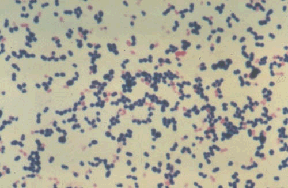(For veterinary information only)
WARNING
The size of the tablet/medication is NOT an indication of a proper dose. Never administer any drug without your veterinarian's input. Serious side effects or death can occur if you use drugs on your pet without your veterinarian's advice.
It is our policy not to give dosing information over the internet.

The Gram positive cell wall takes up purple stain. Cocci are round bacteria. The Gram positive cocci in this picture appear as purple dots. (Image credit: CDC Public Health Image Library)
Brand Name: Clindadrops, Antirobe, Cleosin
Available in 25 mg, 75 mg, 150 mg, 300 mg capsules and tablets
Background
The continuing fight against bacterial infections involves antibiotics capable of harming bacterial cells without damaging the patient’s cells. Biological properties that bacteria do not share with animals have been exploited to accomplish exactly this.
Clindamycin is an antibiotic of the lincosamide class that is used to treat infections, especially anaerobic infections of the mouth, Staphylococcus infections of the skin, toxoplasmosis, and many other protozoal infections.
To understand how the lincosamides work, it is important to understand how proteins are made by cells. The blueprint or code for any protein structure comes from the cell’s DNA. DNA is a sequence of molecules that corresponds to a sequence of amino acids, and when these amino acids are strung up in order according to the DNA code, a specific protein is formed. To get from a strand of DNA to a strand of amino acids, the DNA code must be transcribed onto a strand of messenger RNA, which is in turn read by a cell organ called a ribosome. The ribosome is the key player in the lincosamide antibiotic story as animal ribosomes are very different from bacterial ribosomes. Because of this difference, the lincosamide antibiotic is able to destroy the bacterial ribosome without affecting the animal ribosome. In this way, bacteria cannot make the proteins they need to divide and/or survive, yet the patient's ability to make protein is unharmed. Depending on how much antibiotic is used, the bacterial cell may simply be inhibited from reproducing or may be killed outright.
How this Medication is Used
The lincosamide antibiotics seem to be most useful against the bacteria classified as Gram-positive cocci (classified thus based on their shape and cell wall properties). Staph skin infections would be a common target. Clindamycin is also helpful against protozoans such as Toxoplasma and Mycoplasma, as well as many anaerobic (growing without oxygen) bacteria.
The types of bacteria sensitive to clindamycin make this drug especially popular for use in oral and periodontal infections, skin infections, and bone infections.
Clindamycin is given once or twice daily and may be given with or without food (see below).
Side Effects
Oral clindamycin is unpleasant tasting and may be rejected by some pets.
The most common side effect of clindamycin is diarrhea, which is generally not serious and can be helped by providing probiotics or a prebiotic meal an hour after giving the medication.
More seriously, clindamycin can burn the esophagus if a tablet or capsule sticks in the throat, causing irritation that can lead to potentially serious scarring. For this reason, a syringe of water or some food should be used to chase the medication. This is unlikely to occur except in very small patients. In the event of an esophageal burn, the patient will lose appetite, develop difficulty swallowing, or may have bloody diarrhea.
Interactions with Other Drugs
Erythromycin, another antibiotic, and clindamycin will be less effective when combined than when used separately. There is some evidence that the same is true when clindamycin is combined with chloramphenicol.
Clindamycin will reduce blood levels of cyclosporine when the two are used at the same time.
The use of clindamycin with phenobarbital, a seizure medication, together can make clindamycin less effective.
Clindamycin is commonly used with ketoconazole, an antifungal medication. This combination can boost the clindamycin blood level and possibly increase the likelihood of stomach upset.
Concerns and Cautions
Oral clindamycin is absorbed into the body faster if given on an empty stomach but may be given with or without food.
Clindamycin will cross the placenta if used in pregnant patients. It will also readily be transferred to nursing young and can induce diarrhea.
The dosage may need to be changed in patients with kidney or liver disease. In these cases, a different drug might be a better choice. If this is not possible, it may be helpful to measure blood levels of clindamycin to be sure the patient is able to clear the drug adequately and does not overdose.
Liver enzyme values often go up when using clindamycin. This is not felt to be of health significance but is important to recognize when it is seen.
The manufacturer recommends blood tests of liver and kidney function if clindamycin is to be used beyond 30 days.
This medication is not safe for use in horses, rabbits, rodents, or ruminants.
Clindamycin oral liquid is famous for its especially bitter taste. Oral clindamycin is absorbed into the body faster if given on an empty stomach but may be given with or without food.
Clindamycin liquid does not require refrigeration for storage.